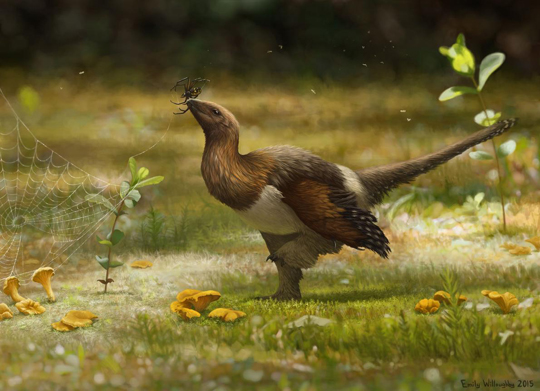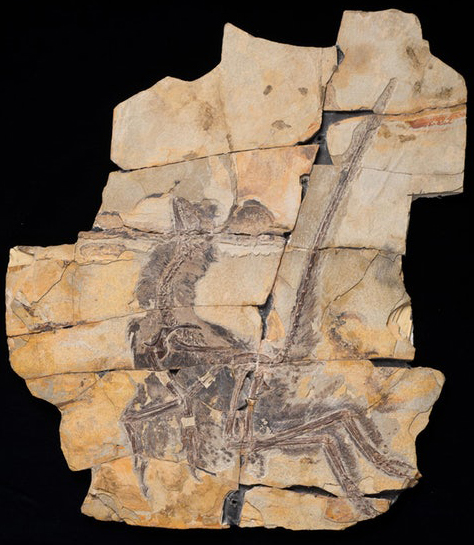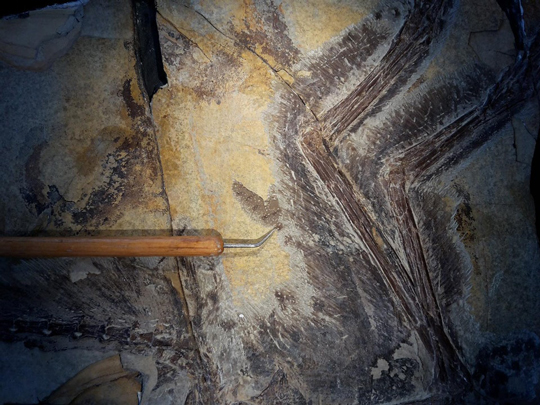Serikornis sungei – Feathered but a Terrestrial Dinosaur
A team of international scientists have ruffled a few feathers amongst their fellow palaeontologists. A new species of feathered, four-winged dinosaur from north-eastern China has been described. Despite its heavily feathered forelimbs and legs, this forty-eight-centimetre-long theropod may have been permanently grounded. Writing in the journal “The Science of Nature”, the scientists, which include lead author Ulysse Lefèvre (Royal Belgian Institute of Natural Sciences in Brussels), describe a basal paravian (member of the Paraves clade of theropods), it has been named Serikornis sungei.
Potentially a Very Down to Earth Feathered Dinosaur – Serikornis sungei
Picture credit: Emily Willoughby
Puzzling Paravians and Their Kin
The single, beautifully-preserved and nearly complete fossil specimen of this dinosaur was discovered in 2014. It comes from the Tiaojishan Formation (Late Jurassic), of Liaoning Province, China, from the same strata that previously yielded another four-winged theropod Anchiornis (A. huxleyi), which was named and scientifically described in 2009. These sediments, which are approximately 160 million-years-old (Oxfordian faunal stage), may also have yielded another four-winged, terrestrial theropod – Aurornis (A. xui). However, Aurornis poses a problem for palaeontologist as they try to unravel the evolution of feathered flight.
The holotype fossil material of Aurornis was acquired from a fossil dealer, who claimed the fossil came from the Upper Jurassic deposits of Western Liaoning. However, Pascal Godefroit, a colleague of Ulysse Lefèvre at the Royal Belgian Institute of Natural Sciences, who was the lead author of the scientific paper that described Aurornis, has expressed doubts on the provenance of the original fossil material. The holotype could have come from the much younger Yixian Formation of Liaoning Province. Aurornis could have lived at least thirty million years after Anchiornis and Serikornis. The lack of appropriate and validated fossil documentation is adding to the difficulties faced by scientists as they try and unravel the evolution of flight.
The Beautifully-Preserved Fossil Skeleton of Serikornis sungei
Picture credit: Ulysse Lefèvre/Royal Belgian Institute of Natural Sciences
“Silky Dinosaur”
The little dinosaur, nick-named “Silky”, because of the silky texture of its integument (covering of feathers), has a skeleton that suggests a terrestrial existence to the researchers. They propose that Serikornis was a ground-dwelling dinosaur with no adaptations for flight, despite having feathers on its arms and legs. Yet, feathery legs have been associated with the evolution of flight in the Dinosauria.
A hypothesis has been proposed that one dinosaur lineage went through a four-winged, gliding phase on the way to powered flight. An example, of which would be the likes of Microraptor, known from Lower Cretaceous-aged deposits from Liaoning. If a terrestrial dinosaur, such as Serikornis had long feathers on its legs, this suggests that such structures evolved in ground-dwelling dinosaurs and a flight function came secondary.
Such feathery legs might have evolved initially for a different reason, perhaps as a result of sexual selection or as a result of an evolutionary drive to produce even more elaborate and visually stunning displays. These feathery legs were then inherited by increasingly aerodynamic and arboreal dinosaurs leading eventually to powered flight amongst the Dinosauria.
Palaeontologist Ulysse Lefèvre Examining the Serikornis Fossil Material
Picture credit: Ulysse Lefèvre/Royal Belgian Institute of Natural Sciences
Lefèvre and his team named the new species in honour of Sun Ge, the scientist at the Palaeontological Museum of Liaoning who made the fossil available for study, and for the presumed silky texture of its body covering. Serikos means “silk” in ancient Greek.
Contentious Fossil Interpretation
Commenting on one of the reasons for the team’s terrestrial diagnosis for Serikornis, Ulysse Lefèvre stated:
“The feathering of Serikornis shows for the first time a complete absence of barbules—that is, the microstructures that allow feathers to resist air pressure during wing beats. The plumage is composed of four wings, as with many theropod dinosaurs from China, but it did not allow “Silky” to take off from the ground or from a tree.”
In the phylogenetic analysis undertaken by the research team, Serikornis is classified as a basal paravian, outside the Eumaniraptora clade, the clade that includes the Deinonychosauria (troodontids and dromaeosaurids), as well as birds. Whilst these scientists propose a terrestrial habit for Serikornis, some palaeontologists disagree. For example, Professor Mike Benton (Bristol University), thinks that presence of hind wings would have made life difficult for this little dinosaur.
Professor Benton explained:
“The hind wings would be inconvenient for a ground-runner. The long feathers on the thigh and calf would be like very elaborate bell-bottomed trousers, rubbing and catching as the animal walked or ran.”
Professor Benton and many other leading academics support the idea that the anatomical arrangement of four wings is a good contender as a transitional stage between gliding and the evolution of powered flight. The professor added that in his opinion the body plan of Serikornis was:
“A model for the origin of flight, in which little dinosaurs such as Serikornis clambered into trees, perhaps chasing insects and other small tree-dwellers for food. To escape predators or to get around, they would glide from bough to bough.”
A Close-up of the Feathers on the Hind Legs of Serikornis sungei
Picture credit: Ulysse Lefèvre/Royal Belgian Institute of Natural Sciences
A spokesperson from Everything Dinosaur commented:
“The discovery of another Late Jurassic four-winged dinosaur helps to increase our knowledge as to the diversity of the feathered theropods, it is very likely that feathers first evolved for other purposes, for example, as insulation, for display. Flight was a secondary function. However, where Serikornis sungei fits into the bigger picture regarding the evolutionary line that led to direct ancestors of today’s birds is open to debate.”
Lefèvre and his co-authors concede it may have been possible for these light, small dinosaurs to parachute from the trees to the ground. The plumage of Serikornis could have slowed its descent, but “controlled falling” is a still a long way from flight. Serikornis had enlarged claws that may have allowed it to climb trees, so this feathered dinosaur could have been at home in arboreal habitats.
To read Everything Dinosaur’s 2009 article on Anchiornis huxleyi: Older than Archaeopteryx! New Evidence of the Dinosaur/Aves Family Tree.
To read Everything Dinosaur’s 2013 article on the discovery of Aurornis: A New Contender for the Title of “First Bird”?
Visit the Everything Dinosaur website: Everything Dinosaur.










Leave A Comment